{Click on an image to enlarge, then use the back button to return to this page}
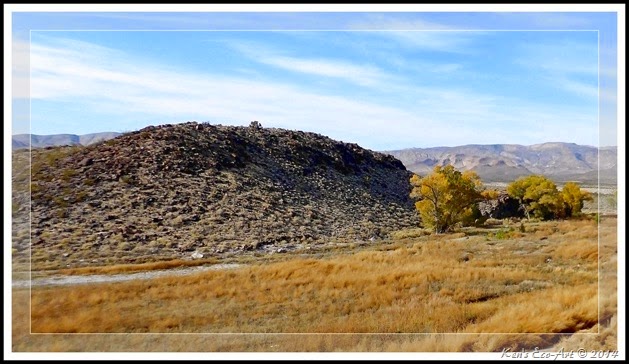 |
| (Fig. 01) |
|
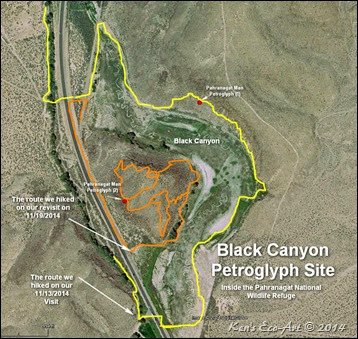 |
| (Fig. 02) |
|
| Site Description: Generally known as the Black Canyon Petroglyph Site, this 10-acre section of the Pahranagat National Wildlife Refuge was placed on the U.S National Register of Historic Places in 1975 as an archeological historic district having significant potential for information to be learned in the future. Back in 2009, there was an extensive volunteer project that documented over 100 rock art panels at seven sites in and around this location. Black Canyon itself is well-known for its concentration of what is referred to as Pahranagat Representational Style petroglyphs - a distinctive anthropomorph style composed of varying treatments of the human form, often called the Pahranagat Man. It is often a headless rectangular form containing internal decoration accompanied by an atlatl-like design. The body of the anthropomorph is sometimes a solid-pecked oval or somewhat rectangular form with a line protruding from the head and with down-turned arms and extended hands as in (Figs. 16 & 17) below. Because this is a style that is restricted in distribution to the Pahranagat Valley area, it seems to point to a localized cultural development. The representation of atlatls would date some of these petroglyphs to more than a 1,000 years old. Refer to the section below titled, The Atlatl. Overall, the projectile points, sherds, and hydration rim values found during the study reflect an Early Ceramic and Late Archaic use—within the last 1,500 years—with Late Archaic indicators significantly outnumbering Early Ceramic ones, underscoring occupations of Black Canyon within the last 750 years. |
|
Site Habitation: Based upon the rock art found here, it appears that a small band of Pahranagats may have once inhabited this area. Located at the top of the large mound are several circular stone areas that may have once been part of a crude shelter. There is also evidence of grinding slicks that were used for the grinding or crushing of seeds and nuts with a stone.
 |
| (Fig. 03) |
The Pahranagat Valley lies at the very edge of what is considered as the Fremont "zone". "Fremont" is the name archaeologists have given to a mysterious group of ancient people(s) who lived between 1,500 and 800 years ago. Though centered in Utah and named for its Fremont River, they spilled over into the neighboring states, including Nevada (Fig. 03). These nomadic peoples are often referred to as "hunter-gatherers" because they had to move from place to place following the seasonal ripening of important plants and the migration of game animals, often caused by the rains or lack thereof. The Fremont culture arose here at a time when there was much more water available. When water was available, they actually began to cultivate maize and other plants, becoming more sedentary. Many archaeologists think that the Fremont people may have developed from the Anasazi (Puebloan culture) (Fig. 03). Whether the Fremont people lived in this area or just passed through, still isn't known for sure. Some scholars think that they were forced out by the Southern Paiute. Whatever the case, it is commonly believed that long periods of drought led to the eventual demise of these cultures in the harsh desert areas. These types of harsh conditions such as a lack of food and water would cause people to travel farther to find them. When it became too hot and dry to grow crops, they would have had to abandon the location and go back to being full-time hunters and gatherers. Click here to learn more about this area ... Understanding Nevada Rock Art. |
|
11/19/2014 Trip Notes (2nd visit): Not having enough time to search for more petroglyphs on my last visit here, I decided to visit this area once again, this time with hiking partners Robert Croke and Blake Smith. After getting an early start, we arrived at the site around 9:00 am and were greeted with absolutely beautiful weather, sunny with some partial cloud cover, perfect for hiking and taking petroglyph pictures. Figure 02 above shows the hiking area (in orange) that we covered on this visit. Starting at the southern end of this rather steep rocky hill (Fig. 01), we walked around it east facing side (Fig. 04) looking for easiest route to the top. As we walked around this side of this outcrop we discovered several interesting rock art panels, often located near the very top. The one pictured in (Figs. 05 & 06) show the representation of a man, an atlatl, and a sheep with an atlatl sticking in its back. Climbing further up on a small ledge, we rounded the corner and found another unique grouping of panels (Fig. 07) located just below the ridgeline. Though the top one seems quite crowded with symbols, the three to the right and below it use the pecking of dots to represent what appears to be a bighorn sheep and a man holding an atlatl (Figs. 08 & 09). A little further along we spotted some more panels containing bighorn sheep (Figs. 10 & 11). After reaching the top and enjoying some of the great views (Figs. 12 & 13), including a view of the Upper Pahranagat Lake, we headed to the west (road) side of the mound (Fig. 14) and began searching for the Pahranagat Man panel. (con’t below)
|
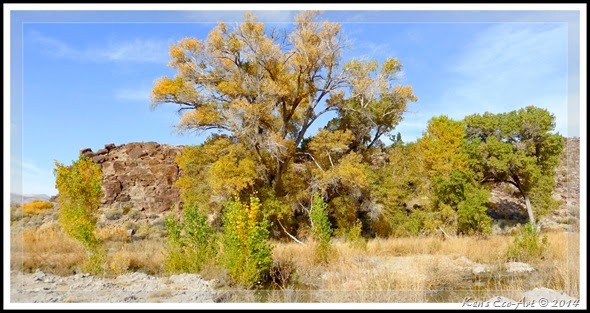 |
| (Fig. 04) |
|
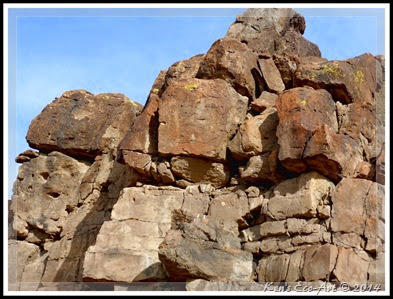 |
| (Fig. 05) |
|
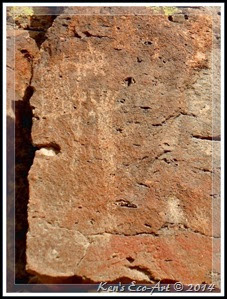 |
| (Fig. 06) |
|
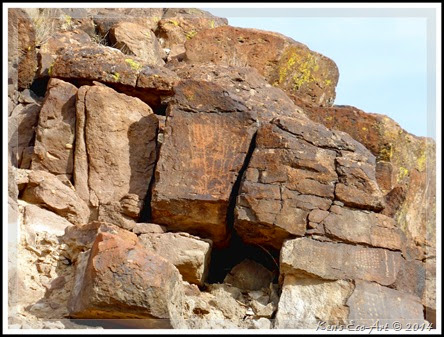 |
| (Fig. 07) |
|
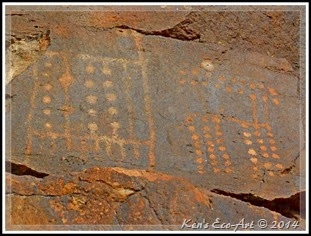 |
| (Fig. 08) |
|
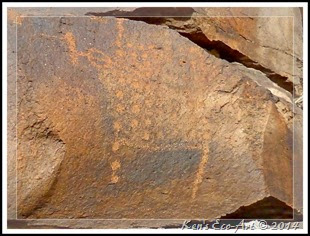 |
| (Fig. 09) |
|
 |
| (Fig. 10) |
|
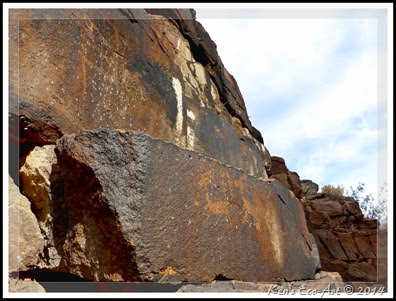 |
| (Fig. 11) |
|
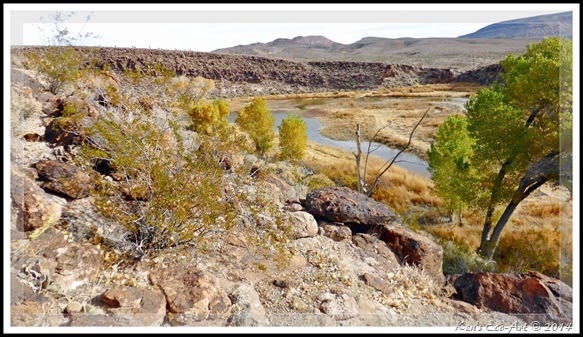 |
| (Fig. 12) |
|
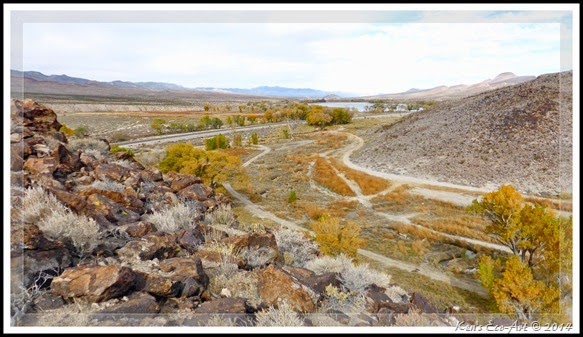 |
| (Fig. 13) |
|
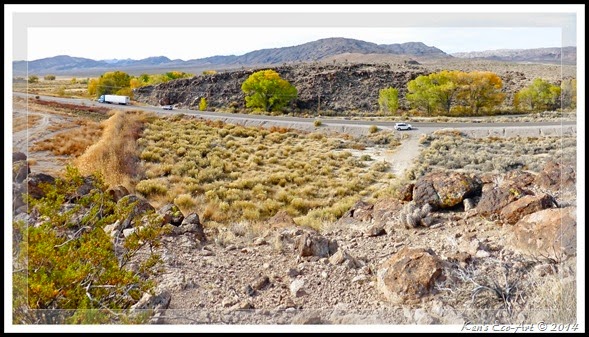 |
| (Fig. 14) |
|
Upon locating and getting my first look at the Pahranagat Man panel (Fig. 15), I was amazed at how large it was. Standing nearly three feet tall, this is without a doubt one of the largest representations of a human form I have ever seen depicted in a petroglyph panel. In addition to the Pahranagat Man, this split-rock panel contained depictions of several sheep, as well as another anthropomorph holding an atlatl (Figs. 16 & 17). Though we didn’t spot anymore petroglyphs, we did find a grinding slick (Fig. 18) and what appeared to be an area where someone may have built some kind of stone shelter (Fig. 19). After a successful morning of hiking, climbing and picture taking we finally headed to the edge of the hill (Fig. 20) and retraced our steps back to the car, seen in (Fig. 14). Because we still had plenty of time, we decided to drive up the road to Ash Springs and visit the Ash Springs Rock Art Site. Click here for info and pictures on this site ... Ash Springs Rock Art Site.
|
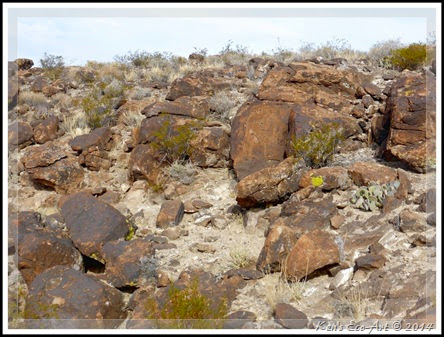 |
| (Fig. 15) |
|
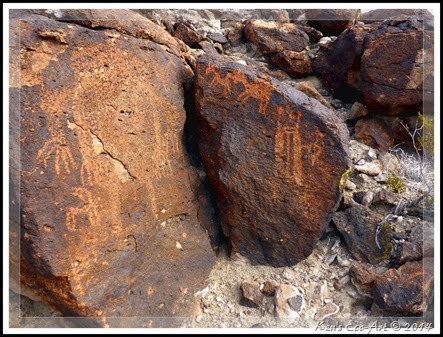 |
| (Fig. 16) |
|
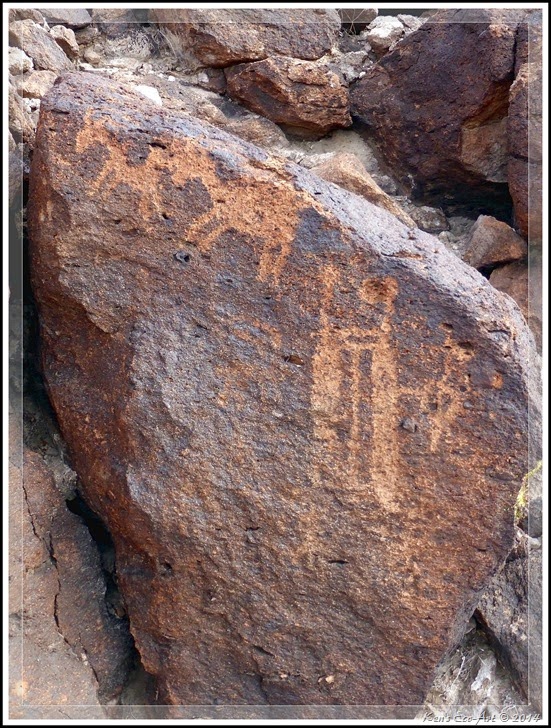 |
| (Fig. 17) |
|
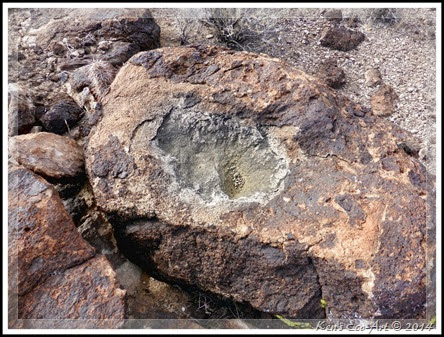 |
| (Fig. 18) |
|
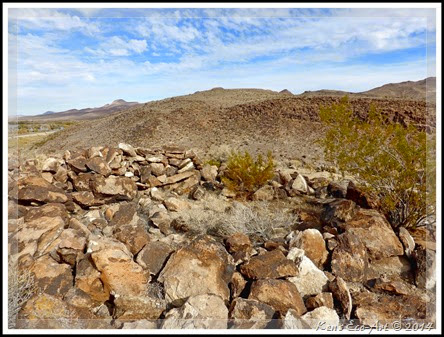 |
| (Fig. 19) |
|
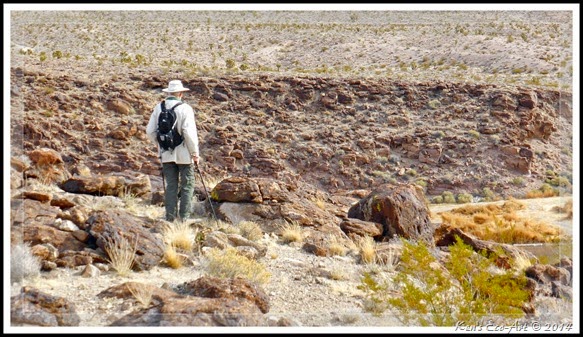 |
| (Fig. 20) |
|
The Atlatl: The atlatl was an ancient tool used by the Anasazi (Puebloan) cultures, 1,500-800 years ago, before the invention of the bow and arrow. Atlatl is an Aztec Indian word for spear thrower. It was a shaft which was used as a lever to increase the power imparted to a spear or dart, allowing them to be thrown further and with greater speed and power.
 |
| (Fig. 21) |
Although details vary, the basic form was a thin, flat strip of hardwood with a hook carved at the end of a groove. It was notched for a split-finger grip and often had a small stone weight bound to the shaft just distal to the finger loops (Fig. 21). The spears or darts were probably made of willow or other light wood armed with a hardwood foreshaft that held a moderate sized stone point. The stone weights are called 'boat stones' or 'banner stone' because of their shapes. Though there are many theories as to what purpose they served, perhaps a counterweight, many believe that it was merely a charmstone, to bring luck to the hunter, though we will never truly know.
 |
| (Fig. 22) |
Because rock art is not usually full of details or photographically faithful to reality, images of atlatls found in petroglyphs very greatly (Fig. 22). The Atlatl is often depicted as simply a circle with a line through it. Representations of atlatlists in action are surprisingly rare, although some have been found as well at zoomorphs with atlatls sticking out of them. It is actually amazing how many of the petroglyph panels found in the Pahranagat Valley zone contain atlatls, several being attached to the back of a bighorn sheep. Though the atlatls was never thrown, it was probably used to depict just the fact that it was used to throw the spear or dart that brought down the animal.
|
|
|
|






















